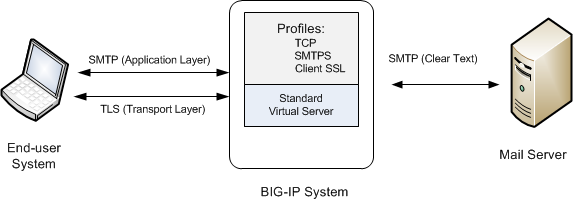Applies To:
Show Versions
BIG-IP AAM
- 11.6.5, 11.6.4, 11.6.3, 11.6.2, 11.6.1
BIG-IP APM
- 11.6.5, 11.6.4, 11.6.3, 11.6.2, 11.6.1
BIG-IP GTM
- 11.6.5, 11.6.4, 11.6.3, 11.6.2, 11.6.1
BIG-IP Analytics
- 11.6.5, 11.6.4, 11.6.3, 11.6.2, 11.6.1
BIG-IP Link Controller
- 11.6.5, 11.6.4, 11.6.3, 11.6.2, 11.6.1
BIG-IP LTM
- 11.6.5, 11.6.4, 11.6.3, 11.6.2, 11.6.1
BIG-IP PEM
- 11.6.5, 11.6.4, 11.6.3, 11.6.2, 11.6.1
BIG-IP AFM
- 11.6.5, 11.6.4, 11.6.3, 11.6.2, 11.6.1
BIG-IP ASM
- 11.6.5, 11.6.4, 11.6.3, 11.6.2, 11.6.1
Overview: Securing client-side SMTP traffic
You can add SSL encryption to SMTP traffic quickly and easily, by configuring an SMTPS profile on the BIG-IP system. SMTPS is a method for securing Simple Mail Transport Protocol (SMTP) connections at the transport layer.
Normally, SMTP traffic between SMTP servers and clients is unencrypted. This creates a privacy issue because SMTP traffic often passes through routers that the servers and clients do not trust, resulting in a third party potentially changing the communications between the server and client. Also, two SMTP systems do not normally authenticate each other. A more secure SMTP server might only allow communications from other known SMTP systems, or the server might act differently with unknown systems.
To mitigate these problems, the BIG-IP system includes an SMTPS profile that you can configure. When you configure an SMTPS profile, you can activate support for the industry-standard STARTTLS extension to the SMTP protocol, by instructing the BIG-IP system to either allow, disallow, or require STARTTLS activation for SMTP traffic. The STARTTLS extension effectively upgrades a plain-text connection to an encrypted connection on the same port, instead of using a separate port for encrypted communication.
This illustration shows a basic configuration of a BIG-IP system that uses SMTPS to secure SMTP traffic between the BIG-IP system and an SMTP mail server.
 Sample BIG-IP configuration for SMTP traffic with STARTTLS activation
Sample BIG-IP configuration for SMTP traffic with STARTTLS activation
Task summary
To configure the BIG-IP system to process Simple Mail Transport Protocol (SMTP) traffic with SSL functionality, you perform a few basic tasks.
Task list
Creating an SMTPS profile
Creating a Client SSL profile
You create a Client SSL profile when you want the BIG-IP system to authenticate and decrypt/encrypt client-side application traffic.
Creating a virtual server and load-balancing pool
Implementation result
After you have created an SMTPS profile and a Client SSL profile and assigned them to a virtual server, the BIG-IP system listens for client-side SMTP traffic on port 25. The BIG-IP system then activates the STARTTLS method for that traffic, to provide SSL security on that same port, before forwarding the traffic on to the specified server pool.





